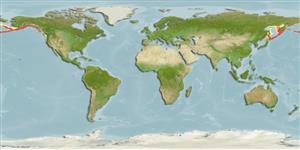Environment: milieu / climate zone / depth range / distribution range
Ecologie
marien bathydemersaal; diepte 76 - 760 m (Ref. 80505). Deep-water
Northern Pacific: Kronotskiy Bay on the southeastern Kamchatka Peninsula through the Bering Sea, Commander and Aleutian Islands, and Gulf of Alaska to the Strait of Georgia and Puget Sound. Records from the Sea of Okhotsk are questionable.
Grootte / Gewicht / Leeftijd
Maturity: Lm ? range ? - ? cm
Max length : 35.6 cm SL mannelijk / geslacht onbekend; (Ref. 80505)
Korte beschrijving
Morfologie | Morfometrie
Dorsale zachte stralen (totaal): 102-114; Anale zachte stralen: 90 - 102; Wervels: 109 - 122. This species is distinguished from L. diapterus in having scales on the nape, but not covering entire top of head to posterior margin of the orbits, usually extending anteriorly only to the occipital pores, and in having lower dorsal-fin ray (usually 111 or fewer), anal-fin ray (usually 101 or fewer), vertebral (usually 119 or fewer), and gill raker (usually 15 or fewer) counts. It differs from L. hubbsi in pectoral-fin ray count (18-21 vs. 20-23), in the position of first dorsal-fin pterygiophore (sixth or seventh interneural gap vs. third), and color pattern (L. beringi without narrow light bands extending onto dorsal fin and across nape). It differs from the L. nakamurae group in having 4 postorbital pores (vs. 1 or 2), the posteriormost without a short tube; rounded lower pectoral-fin lobe with tips of the rays rounded and the middle rays often branched, fin membrane not incised (vs. pointed, with rays pointed and unbranched, membrane moderately incised); scales usually present on base of pectoral fin; light inverted V-shaped bands usually present on body (Ref. 80505).
Levenscyclus en paargedrag
Maturiteit | Voortplanting | Paaien | Eieren | Fecunditeit | Larven
Stevenson, D.E. and B.A. Sheiko, 2009. Clarification of the Lycodes diapterus species complex (Perciformes: Zoarcidae), with comments on the subgenus Furcimanus. Copeia 2009(1):125-137. (Ref. 80505)
Status op de Rode Lijst van het IUCN (Ref. 130435)
Gevaar voor de mens
Harmless
Gebruik door de mens
Meer informatie
Leeftijd/GrootteGroeiLengte-gewichtLengte-lengteLengtefrequentiesMorfometrieMorfologieLarvenLarvale populatiedynamiekRekruteringAbundantieBRUVS
ReferentiesAquacultuurAquacultuurprofielKweeklijnenGeneticaElectrophoresesErfelijkheidZiektesVerwerkingNutrientsMassaconversie
Tools
Speciale rapporten
Download XML
Internetbronnen
Estimates based on models
Preferred temperature (Ref.
123201): 1.1 - 5.9, mean 3.7 °C (based on 144 cells).
Fylogenetische diversiteitsindex (Ref.
82804): PD
50 = 0.5000 [Uniqueness, from 0.5 = low to 2.0 = high].
Bayesian length-weight: a=0.00120 (0.00057 - 0.00252), b=3.10 (2.91 - 3.29), in cm total length, based on LWR estimates for this (Sub)family-body shape (Ref.
93245).
Trofisch niveau (Ref.
69278): 3.4 ±0.5 se; based on size and trophs of closest relatives
Weerstandsvermogen (Ref.
120179): Zeer laag, minimale populatieverdubbelingstijd meer dan 14 jaar (Preliminary K or Fecundity.).
Fishing Vulnerability (Ref.
59153): Low to moderate vulnerability (33 of 100).
